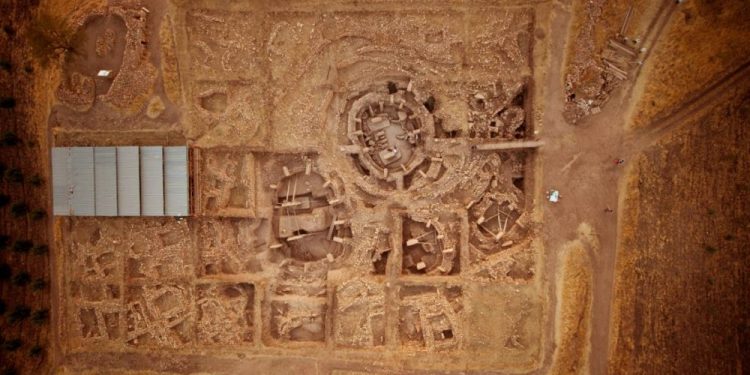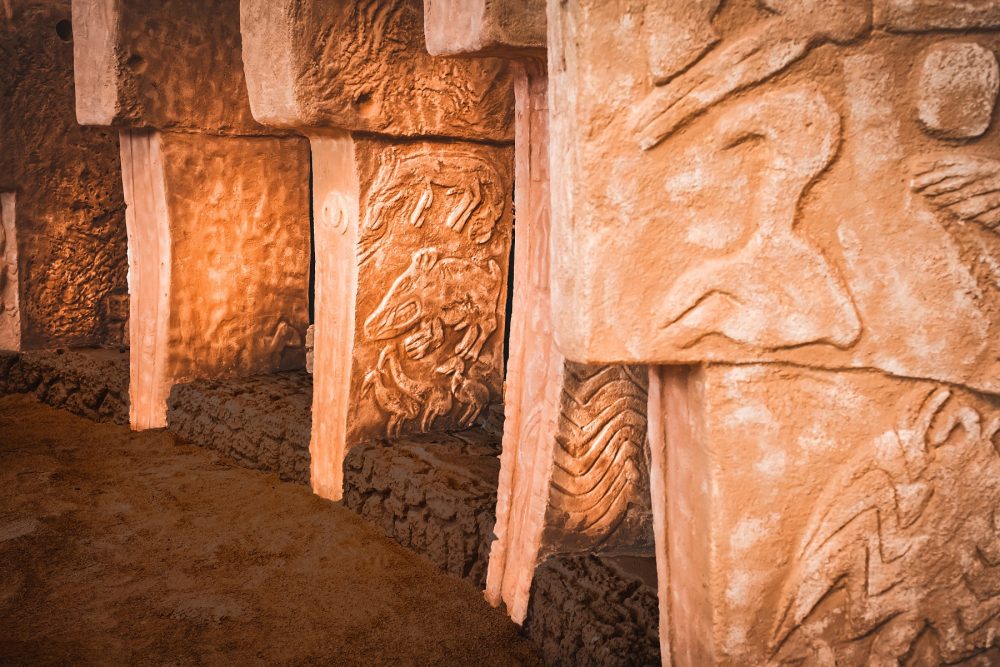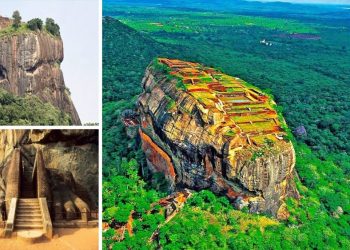In present-day Anatolia–Turkey–lay the remnants of the oldest megalithic site on Earth. Believed to have been constructed some 13,000 years ago by mysterious people, the ancient site identified as Göbekli Tepe is shrouded in mystery for more reasons than one. It is one of the most enigmatic sites on the planet and doesn’t fit anywhere within the historical timeline set forth by present historians. This is because there is nothing like it out there.
Lost Civilization and Not an Ancient Monument
Göbekli Tepe is so old that it should not even exist. Experts maintain that the massive site–which has only been excavated around 5% to date–was built by an “uncivilized” group of people, most likely hunter-gatherers. But was it? To find out, we must turn our history books to 1994 when German archaeologist Klaus Schmidt “discovered” the massive complex buried beneath the surface.
Discovering Göbekli Tepe
Although officially discovered and cataloged in 1994, the site was “found” by American archaeologists in the ’60s. Back then, however, not much importance was given to the site because experts thought that the site’s sections protruding from the surface were no more than tombstones dating back to the time of the Byzantine Empire. The site was left unexplored until Schmidt came along some thirty years later. Unlike his American colleagues, Schmidt knew the site was far older than archaeologists initially thought upon seeing the stone fragments. The surface features of Göbekli Tepe led Schmidt to quickly deduce that this was a prehistoric site and not medieval as previously thought. With each exploration, the importance of the site was revealed further.
Unnoticed for ages
Strangely, for hundreds of years, the site’s importance was unnoticed. The hill that makes up the site had been cultivated for generations, and the local inhabitants had removed some of the rocks, piling them in heaps to clear the fields. This is a shame since many archaeological pieces of evidence have been destroyed during this process. After decades of explorations and excavations, archaeologists say that around 5% of the site has been excavated. Although most of it remains underground, experts have categorized the ancient site as the oldest temple on the planet, while others suggest it may have been an astronomical observatory.
I beg to differ. The complexity of the site, its massive size, and its intricate features tell a more fabulous story. One that experts have missed to this date.
Göbekli Tepe; Civilization or hunter-gatherers?
Mainstream experts argue that it is impossible that 12,000 years ago, complex societies existed near the border between present-day Turkey and Syria. The mainstream narrative explains that civilization as we know it did not exist at this time in history. Göbekli Tepe’s existence is an obvious indicator that this is not so. The site’s sheer size tells us that hunter-gatherers were unlikely the site’s founders. The world’s oldest megalithic site–the complex of Göbekli Tepe–has a secret to tell.
How likely is it that between 12,000 and 13,000 years ago, a small group of hunter-gatherers decided to erect a supermassive site in the foothills of the Taurus Mountains? Very unlikely if you carefully inspect less than 5% of the site excavated to this date. The builders of the site- an advanced society, part of a long-lost civilization missing from our history books- had the ability not only to quarry massive stones, the heaviest of which has been estimated at around 50 tons.
Advanced society
Not only did this civilization have the ability to quarry the stones, but they also possessed the means to transport the massive material to the site where the structures were raised. Schmidt has claimed that “the work of quarrying, transporting and erecting tons of heavy, monolithic, and almost universally well-prepared limestone pillars […] was not within the capability of a few people.” Unorganized hunter-gatherers or groups of hunter-gatherers would not have needed to build such a site, nor would they have been motivated in the first place. If this were the case, why are we not seeing similar supermassive structures erected around the globe, built by “hunter-gatherers”?
Why? Because hunter-gatherers did not build it.
Supermassive stones
Göbekli Tepe predates the Egyptian pyramids by several thousand years. We know that the civilization that built the pyramids was a complex society, developed and skilled, backed by a flourishing economy and abundant raw materials. The ancient Egyptians used multi-ton stones to build the pyramids. Although how these amazing structures were built remains a profound mystery, we can propose several theories on how they made it possible.
Göbekli Tepe, however, is shrouded in mystery even further, and not just because of its size. Several thousands of years before the ancient Egyptians, the mysterious society that erected Göbekli Tepe developed the technology to quarry, transport, and position the supermassive stones. Most of the stones used in the site construction weigh around 10 tons. Analysis of the site suggests there are 20 circles within which lie hundreds of stone pillars. However, only four of these circles have been excavated to date.
Hundreds of people
Understanding the labor necessary to build such a complex and massive site is nearly impossible. Archaeologists estimate that it took more than 500 people to extract the stones ranging between 10 and 20 tons (although some weigh more than 50) from local quarries and move them between the quarries and the construction site. Were hunter-gatherers really capable of organizing such a massive workforce 13,000 years ago? And if so, what motivated them to do this? Some experts argue that slaves may have been used to complete their construction, but no evidence supports that theory.
Planning, engineering, and a sense of architecture
You do not build a site the size of Göbekli Tepe randomly. Creating something of such proportions requires planning, practice, and a sense of architecture and engineering. The incredible size of Göbekli Tepe is evidence that its builders knew–advanced knowledge–of planning, engineering, and a refined sense of architecture and art.
The site was not randomly built, but all of its pillars and circles follow a pattern that reveals the complexity of the site. In addition, the workmanship at the site suggests that its builders were a society well-versed in various sciences, including geometry and even mathematics.
Predating metallurgy and writing
These structures at Göbekli Tepe not only predate the invention of ceramics, metallurgy, writing, or the wheel but were erected before the so-called Neolithic Revolution. In other words, the construction of Göbekli Tepe implies an organization at a level of complexity not associated, until now, with pre-Neolithic societies. This leads us to question whether ordinary hunter-gatherers, who did not possess knowledge of writing–and therefore planning–could have erected such a complex site.
Geometric wonder
The complexity of Göbekli Tepe was confirmed in a 2020 study that demonstrated that its builders had a profound knowledge of applied geometry. The study published in the Cambridge Archaeological Journal reveals that Göbekli Tepe was far more advanced than initially thought. Its construction required much more complex planning and resources than previous estimates.
As explained earlier, the planning required to construct Göbekli Tepe was unlike anything seen in that part of history. Researchers have demonstrated that Göbekli Tepe’s circles were not built individually and randomly but were planned as a single unit and were constructed simultaneously. One of the study’s researchers revealed that “the initial discovery of the site was a big surprise, and we are now showing that its construction was even more complex than we thought.”
Göbekli Tepe is a true geometric wonder not built by ordinary hunter-gatherers.
The Stonehenge and Gobekli Tepe connection
Perhaps one of the fascinating tell-tale signs that back up the theory of Gobekli Tepe as a civilization is the results of a scientific paper published in the journal Nature Ecology & Evolution. The researchers offer conclusive evidence that the ancestors of the builders of Stonehenge originated from present-day Anatolia in Turkey, the region where Gobekli Tepe stands. An extensive study of DNA from late Stone Age Britons indicates that the ancestors of the people that built Stonehenge followed a long migratory route along the Mediterranean–starting in Turkey– seeding knowledge of megalithic building along the way. Furthermore, the researchers believe that the distant travelers from present-day Turkey likely were the ones who introduced agriculture and farming to the people of Britain thousands of years ago.
An artists’ treasure trove
In addition to the massive stones weighing 10, 20, and even 50 tons, the variety of fauna described, from lions and wild boars to birds and insects, make a single explanation problematic. However, the symbols at Göbekli Tepe attest to a society well-versed in symbolism and art. A series of minor stone artifacts, statues, and items raises more questions than answers. Given its rich diversity, the mixture of artifacts found at Göbekli Tepe cannot be attributed to one period or another.
Built by hunter-gatherers and abandoned by hunter-gatherers?
Building a site of such complexity and size 13,000 years ago is mind-boggling. It took a great effort to build the site and maintain it. Göbekli Tepe’s size suggests it was of great importance to the people that constructed it. So why was it buried around 8,000 BC? If hunter-gatherers built it, as mainstream scholars suggest, wouldn’t these nomadic people abandon it and move on? And, how could such an “underdeveloped” people have built such a monument in terms of size?
Building such a site required a massive effort, but burying it entirely was an even more remarkable achievement. This raises another important question; why was it buried? Unfortunately, we cannot answer this question today, but perhaps further excavations of the site will reveal more clues to help us understand Göbekli Tepe’s downfall.
Göbekli Tepe, a central site with many others
Perhaps what most supports the theory that the builders of Göbekli Tepe were part of an ancient civilization is the existence of many other similar, albeit smaller, sites. One such example is a site called Nevalı Çori. This site is exciting because of a series of figurines fired at temperatures between 500 and 600 °C. Furthermore, it was here where archeologists also discovered the oldest domesticated Einkorn wheat.
Their existence provides conclusive evidence of the development of ceramic firing technology predating the advent of pottery. The similarity between the monuments at Göbekli Tepe and those at Nevalı Çori undoubtedly suggests that the builders were part of the same “civilization.” Strata at the site indicate human presence over 12,000 years ago.
Conclusion
Our limited understanding of Göbekli Tepe raises more questions for archaeologists than it offers answers. For example, we have no idea how hunter-gatherers were able to build, increase and maintain this considerable complexity in pre-Neolithic social conditions. What adds to the mystery is that we cannot “read” and accurately interpret the pictograms of the site, so we don’t know what the animal reliefs and other symbols meant to the people that erected the site.
I believe that the builders of Göbekli Tepe were no ordinary hunter-gatherers but part of a complex society that has since been forgotten and lost in the annals of history. There is conclusive evidence that Anatolia and present-day Syria regions were home to complex societies during a time when mainstream experts tell us there were none. Maybe it is time to re-analyze our origins and re-write our history books.
Join the discussion and participate in awesome giveaways in our mobile Telegram group. Join Curiosmos on Telegram Today. t.me/Curiosmos
Sources:
• Biblical Archaeology Society. (2021, July 8). The Göbekli Tepe ruins and the origins of Neolithic Religion.
• Bressan, D. (2021, June 25). Controversial theory claims comet impact sparked human civilization. Forbes.
• Dietrich, L., Meister, J., Dietrich, O., Notroff, J., Kiep, J., Heeb, J., Beuger, A., & Schütt, B. (n.d.). Cereal processing at Early Neolithic GÖBEKLI TEPE, southeastern Turkey. PLOS ONE.
• Fagan, A. (n.d.). Hungry architecture: Spaces of consumption and predation at Göbekli Tepe. Taylor & Francis.
• Global Heritage Fund. (2021, January 21). Göbekli tepe: Discovering the world’s oldest religious site.
• Haklay, G., & Gopher, A. (2020, January 14). Geometry and architectural planning at GÖBEKLI Tepe, Turkey: Cambridge archaeological journal. Cambridge Core.
• Nykamp, M., Knitter, D., & Schütt, B. (2020, July 11). Sediment descriptions and geochemical analyses OF RADIOCARBON-DATED deposits from the vicinity Of Göbekli TEPE-A DATASET. Data in Brief.
• Sweatman, M. (2021, May 13). The younger Dryas IMPACT hypothesis: Review of the impact evidence. University of Edinburgh Research Explorer.
• Tobolczyk, M. (2016, October 18). The world’s Oldest temples in Göbekli Tepe AND Nevali Çori, Turkey in the light of studies In ontogenesis of architecture. Procedia Engineering.











